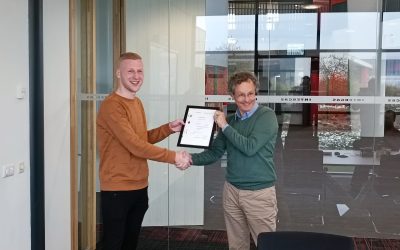Gunnebo: On the road to ‘World Class Performance’
World class performance, that’s what we want to achieve,” said Andy Puhl, plant manager of Gunnebo Doetinchem. That’s why we started a project with Symbol called “Business Excellence. A strategy for future continuity has been developed. We are working toward a transparent organization in which roles, authority, responsibilities and business processes are clear. Each employee gains insight into their own behavior and the effect of their own actions.
“Our ambition is to become a ‘world class’ organization.”
Gunnebo is a publicly traded company in Sweden. The Gunnebo Doetinchem business unit manufactures the fire and burglary resistant safes behind the ATMs. In 2005, a new product was developed, suitable for a global market. An important innovation combined with a very competitive price made it a huge success. “In 2005 the first 8,000 units were produced and in 2006 we suddenly made more than 20,000 units,” said Andy Puhl, plant manager of Gunnebo Doetinchem. In subsequent years, partnerships were established worldwide to continue to meet demand.
Lean, the beginning
Gunnebo is in an OEM market, a high-volume, low-margin market. There is tremendous pressure to stay competitive. So there was the need for efficient operations to control costs in order to remain competitive. Gunnebo’s main customer demanded Supplier Productivity Improvement (SPI) in late 2009. A key component of SPI was Lean. Experts from the client worked with consultants from Symbol at Gunnebo to guide the lean implementation in production. “As we achieved successes and recognized the enormous further potential, we decided to broaden the knowledge of Lean within our organization ourselves. That’s where Symbol came into the picture. The entire process delivered tremendous benefits. You really saw productivity rise significantly and rejection drop.”
World Class
“In the fourth quarter last year, we took some time to look back at our organization and the events of the past year. We found that a lot had improved in and around the production process. We then got the idea that if we wanted to become ‘World Class,’ we should also address the indirect organization. We wanted to improve quality here by improving and securing the processes. This became the ‘Business Excellence’ project.”
Business excellence, from passive to proactive
Andy: “The goal of the ‘Business Excellence’ project was, the name says it all, to achieve business excellence. We were much further along on the shop floor than in the indirect organization. So we definitely needed to address the indirect organization as well, so that together we could take the organization to the next level. To do this, the corporate culture needed to change. From being passive and behind the times to being proactive. First, there had to be internal awareness that this was a necessary step to move the company forward.”
Structure without losing flexibility
“In production, every detail of the process was thought about and the process was secured. In the indirect organization, from history, things were done the way they were done. It was a matter of getting clear what is expected of an employee. This will make the organization more transparent. We started the process with 2 sessions. The first session asked the question, “Who are we really?” Through this session, employees gained insight into their own behavior and the effect of their own actions. In the 2nd session, the theme was “How do we get along?” Individual coaching sessions discussed how you as an individual manager can make a difference in the organization and contribute to organizational goals.
Knowledge and insight with the management dashboard
“We started to concretize. We explicitly identified the organization’s focal points and attached KPIs to them in order to manage them. In the past, it was mainly financial. Now we have agreed with the process owners that there should be a parameter for each process that is monitored and controlled. And to which you can also attach concrete goals, SMART. Furthermore, we are now actually getting the organization with roles and responsibilities on paper and with the people. For us, those are big steps and it’s a huge change for people.
Insight into our business processes increased dramatically
The knowledge about our processes has grown tremendously. What was previously based on history and experience is now captured in data. This also helped us a lot during our move from processes to India. We know our own processes exactly and look only at what is different there. For example, climate. We then collectively ask the question, how can we organize and control this? We are constantly striving for improvements to ensure our continuity. After all, a market player can always emerge that is better than us.
A learning organization
We approach everything positively. It can’t actually go wrong. Because you learn from it. The willingness to want to change and run with the direction of the organization is actually the best thing I see happening right now. Small successes we name explicitly and celebrate. You then have an image that there is also a lot going right. That’s what I learned last year. Information and communication, bringing people along, is very important in any change process. In a clear and structured way. You have to show the big picture and indicate where you are in the journey from A to B. Otherwise, people only see A. There is quite a dynamic, both in the market and in the organization, which makes it fun. If you do the same with a club of people who are just as enthusiastic and you achieve great results what more could you want?”
Latest news/blogs
From Theory to Practice: Junior Consultant at Stoneridge
From theory to practice: Junior Consultant at Stoneridge Before working at Symbol, Junior...
Optimize Quality Management with AI Tools
Optimize quality management with AI tools In the modern business environment, quality management...
The Netherlands’ youngest Black Belt speaks
A ideal is not yet not a solutionEmiel recently gave a training session on the topic of problem...


